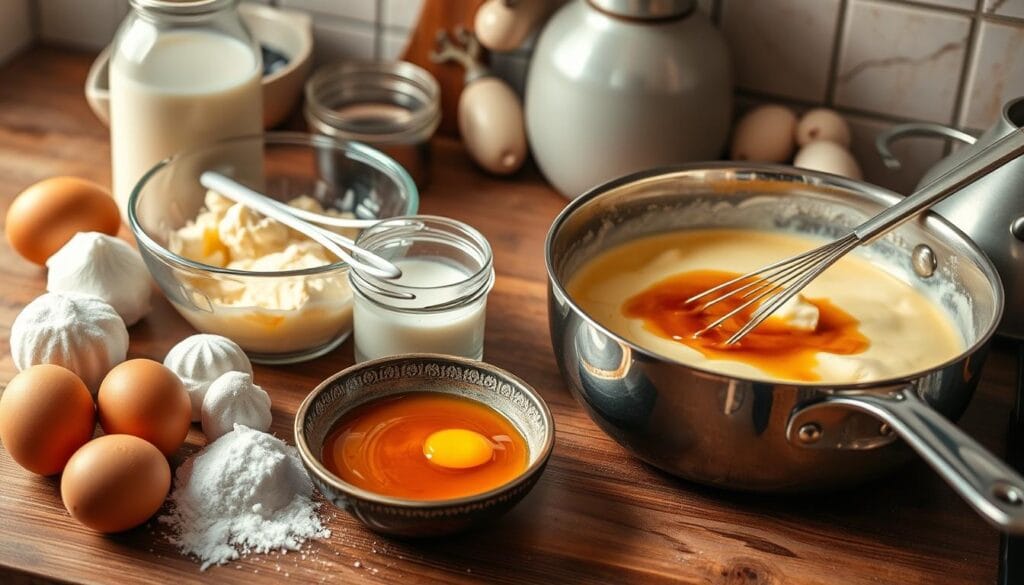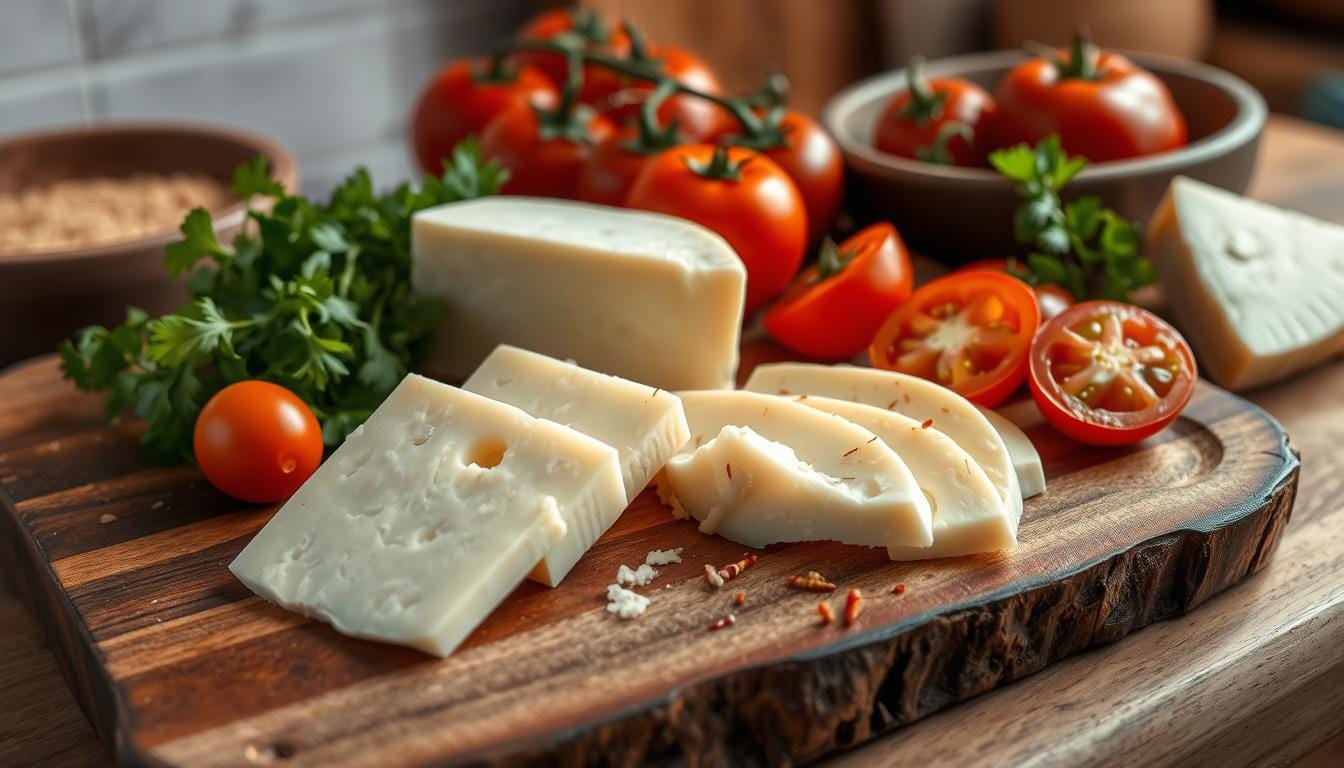Exploring quesillo takes you on a journey through its rich history and cultural importance. This semi-soft, stringy cheese comes from Latin America, mainly Oaxacan Mexico. Its creamy texture and unique taste make it a staple at family gatherings and in cooking traditions.
Whether you love food, cooking, or just want to learn, diving into quesillo is rewarding. You’ll learn about its making, from curdling milk to stretching it. You’ll see how it melts well, making it great for many dishes. Discovering quesillo’s role in Venezuelan culture, where it’s like a flan, is fascinating.
Key Takeaways
- Quesillo is a semi-soft, stringy cheese with a rich history and cultural significance in Latin America.
- Quesillo cheese is known for its creamy texture and unique flavor, making it an integral part of family gatherings and culinary traditions.
- Quesillo can be used in various dishes, from traditional desserts to savory meals, due to its exceptional melting properties.
- Proper storage of quesillo involves refrigeration in an airtight container to maintain its texture and freshness.
- Quesillo provides essential nutrients, including calcium, protein, and vitamins, making it a great addition to a balanced diet.
- Quesillo can be found in Latin American grocery stores, specialty cheese shops, or purchased online, making it accessible to cheese lovers worldwide.
- Quesillo is a versatile ingredient that can substitute other cheeses, such as mozzarella, in recipes, but will alter the flavor.
What is Quesillo?
When you dive into Latin American food, you might find quesillo. But what’s in quesillo? It’s a cheese from Mexico, loved for centuries. It comes from cow and goat milk, thanks to the country’s indigenous roots.
Quesillo is not like flan, which is sweet. It’s savory and often served with meals. Its creamy texture and special flavor come from heating and cooling the milk and adding cheese cultures.
A Brief History of Quesillo
Quesillo’s story begins with Mexico’s indigenous people. It was made from cow and goat milk, a key part of Mexican food. Today, quesillo is enjoyed worldwide, not just in Mexico.
Ingredients That Make Quesillo Unique
What makes quesillo special? It’s the mix of:
- Milk
- Cream
- Cheese cultures
These ingredients blend to make a creamy, tasty dish. If you’re adventurous or love Latin food, try quesillo.
| Ingredient | Quantity |
|---|---|
| Milk | 1 cup |
| Cream | 1/2 cup |
| Cheese cultures | 1 tablespoon |
The Different Varieties of Quesillo
Exploring quesillo cheese reveals a wide variety of tastes and textures. From the creamy north to the tangy south, each area has its own quesillo style. But, is quesillo the same as mozzarella? They are different in taste, texture, and how they’re made.
Regional Differences in Preparation
Quesillo is crafted in many places, each with its own way of making it. Venezuelan Quesillo, for example, includes whole eggs, whole milk, and vanilla. Mexican Quesillo, or Oaxaca cheese, is made with cow’s milk and tastes mild and slightly tangy.
Comparison with Other Cheeses
Quesillo is like mozzarella in being creamy and mild. But, quesillo tastes more delicate, with hints of sweetness and nuttiness. Here’s how quesillo compares to other cheeses:
- Quesillo: creamy, mild, and slightly sweet
- Mozzarella: soft, white, and mild
- Feta: salty, crumbly, and tangy
In conclusion, quesillo’s many varieties offer a rich culinary experience. Whether you prefer creamy or tangy, quesillo has it. So, is quesillo the same as mozzarella? While similar, quesillo is a unique and tasty cheese worth trying on its own.
| Cheese Variety | Texture | Flavor |
|---|---|---|
| Quesillo | Creamy | Mild, slightly sweet |
| Mozzarella | Soft | Mild |
| Feta | Crumbly | Salty, tangy |
How to Make Quesillo at Home
Making quesillo at home is fun and rewarding. You’ll need basic equipment and practice. It’s important to know the difference between queso and quesillo.
Essential Tools and Equipment
You’ll need a medium saucepan, a hand mixer, and a 9×13 inch baking dish. A thermometer is also necessary to get the caramel right.
Step-by-Step Preparation Guide
First, preheat your oven to 350°F (175°C). In a saucepan, mix 1 cup of milk, 14 oz of condensed milk, and ½ cup of sugar. Heat it over medium, stirring constantly, until the sugar dissolves. Then, remove it from heat and let it cool.
In another bowl, whisk 6 large eggs and 1 teaspoon of vanilla extract. Add this to the cooled milk mixture and stir well.

Common Mistakes to Avoid
A common mistake is not cooking the caramel to 220 ºC (428 °F). Also, don’t serve the quesillo before it cools and sets properly.
| Ingredient | Quantity |
|---|---|
| Milk | 1 cup |
| Condensed Milk | 14 oz |
| Sugar | ½ cup |
| Eggs | 6 large |
| Vanilla Extract | 1 teaspoon |
By following these steps and avoiding common mistakes, you can make delicious quesillo at home. Remember, practice makes perfect. Don’t get discouraged if your first batch doesn’t turn out right.
Popular Dishes Featuring Quesillo
Quesillo is a versatile cheese that can be used in many dishes. It’s great in traditional Mexican cuisine and modern fusion dishes. You can enjoy it in tacos, salads, and as a topping for various meals.
Some popular dishes featuring quesillo include quesillo tacos, which are a flavorful delight. Also, quesillo in salads adds a crisp and creamy texture. Pairing it with pesto is an unexpected but delicious combination.
When cooking with quesillo, you can try different recipes and ingredients. Quesillo cheese is a great addition to many meals. Its mild flavor makes it versatile for various cuisines.
Some ideas for using quesillo in your cooking include:
- Adding it to tacos or salads for extra flavor and texture
- Using it as a topping for soups or baked potatoes
- Pairing it with pesto or other sauces for a delicious and unexpected combination
With its rich flavor and creamy texture, quesillo is a great ingredient to have in your kitchen. Whether you’re making traditional Mexican dishes or trying new recipes, quesillo cheese is a great choice.
The Nutritional Benefits of Quesillo
Exploring quesillo reveals its many health benefits. It’s packed with protein and calcium, making it great for a healthy diet. With about 6 grams of protein per ounce, it’s a big protein source.
Quesillo is also high in calcium. This mineral is key for strong bones and teeth. A 100-gram serving has about 536 milligrams of calcium, helping support bone health.
- High protein content: 6 grams per ounce
- Rich in calcium: 536 milligrams per 100 grams
- Low in carbohydrates: 1 gram per ounce
- Good source of fiber: 0 grams per ounce
It’s important to watch the calorie and fat in quesillo. With 80-110 calories per ounce, it’s okay in moderation. Quesillo is a nutritious and tasty addition to any meal, bringing essential nutrients and health benefits.
| Nutrient | Per Ounce | Per 100g |
|---|---|---|
| Calories | 80-110 | 160 |
| Protein | 6g | 20g |
| Calcium | 20-25% DV | 536mg |
Pairing Quesillo with Wine and Other Beverages
Quesillo cheese pairs well with many drinks. You can enjoy it with white wine like Sauvignon Blanc or Pinot Grigio. These wines complement its creamy texture.
For those who prefer not to drink alcohol, try agua fresca or limonada. These drinks are refreshing and cut through the richness of the cheese.
Best Wine Choices for Quesillo
Here are some top wines for quesillo:
- Chardonnay
- Merlot
- Riesling
Non-Alcoholic Pairing Suggestions
Here are some non-alcoholic options for quesillo:
- Fresh fruit juices, such as orange or grapefruit
- Sparkling water with a squeeze of lime or lemon
- Iced tea or herbal tea, such as peach or berry

Tips for Storing Quesillo
To keep your quesillo cheese fresh, it’s key to store it right. Refrigerate it at 40°F (4°C) or below. Before putting it in the fridge, let it cool to room temperature for about 25 minutes. This helps stop bacteria growth and keeps the cheese quality high.
Wrap quesillo tightly in plastic wrap or aluminum foil. Then, put it in an airtight container. This keeps moisture and contaminants out. Also, keep it away from strong-smelling foods to avoid absorbing odors.
Best Practices to Maintain Freshness
- Store quesillo in the refrigerator at a temperature of 40°F (4°C) or below.
- Cool quesillo to room temperature before refrigeration.
- Wrap quesillo tightly in plastic wrap or aluminum foil.
- Place quesillo in an airtight container.
By following these tips, you can enjoy your quesillo cheese longer. It can stay fresh in the fridge for up to 3-4 days. After that, its quality may drop, and it might not be safe to eat.
How Long Does Quesillo Last?
The shelf life of quesillo varies based on storage and handling. Generally, it lasts 3-4 days in the fridge. Always check for spoilage before eating it.
| Storage Method | Shelf Life |
|---|---|
| Refrigeration | 3-4 days |
Quesillo in Global Cuisine
Quesillo has made a big splash in the world of food. Its unique taste and texture have become a favorite in many Latin American countries. In Nicaragua, for example, quesillo is a beloved street food. It’s made with soft cheese, tortillas, pickled onions, and crema.
In Venezuela, quesillo is a special treat, often enjoyed at birthdays and celebrations. It’s made with eggs, condensed milk, whole milk, and sugar. This mix creates a light and airy texture, perfect for desserts.
Influence on Latin American Food
Quesillo has greatly influenced Latin American cuisine, like in Mexico and Nicaragua. In Mexico, quesillo makes up about 10% of cheese production, with over 40,778 tons made each year. It also helps create jobs in many areas, from transportation to tourism.
Quesillo’s Presence in Gourmet Cooking
Quesillo’s unique taste and texture have made it a hit in gourmet cooking. Chefs worldwide use it in creative dishes. Whether in traditional Nicaraguan food or modern recipes, quesillo adds a rich, creamy flavor.
| Country | Quesillo Production | Annual Production Volume |
|---|---|---|
| Mexico | 10% of total cheese production | 40,778 tons |
| Nicaragua | Traditional street food | N/A |
Frequently Asked Questions About Quesillo
As you’ve explored the rich history and delectable flavors of
quesillo
, you may have some lingering questions. Let’s address a few common myths and provide guidance on selecting high-quality
quesillo cheese
Common Myths Debunked
Contrary to popular belief,
quesillo
is not just a variation of traditional flan. While they share some similarities,
quesillo
has its own distinct texture and flavor profile. Unlike flan’s smooth, creamy consistency,
quesillo
is known for its slightly porous and firmer structure, often described as having a « cheesy » quality.
How to Choose Quality Quesillo
When selecting
quesillo
, look for a cheese that has a dense, slightly rubbery texture with small air pockets throughout. The color should range from a pale ivory to a deeper golden hue, depending on the recipe. Avoid
quesillo
that appears overly gelatinous or watery, as this may indicate a lower-quality product. Freshness is key, so opt for
quesillo
that was recently made or has a clear expiration date.
With this guide, you’re now ready to fully enjoy
quesillo
. Explore its diverse flavors and textures. This beloved Venezuelan delicacy is waiting for you.
